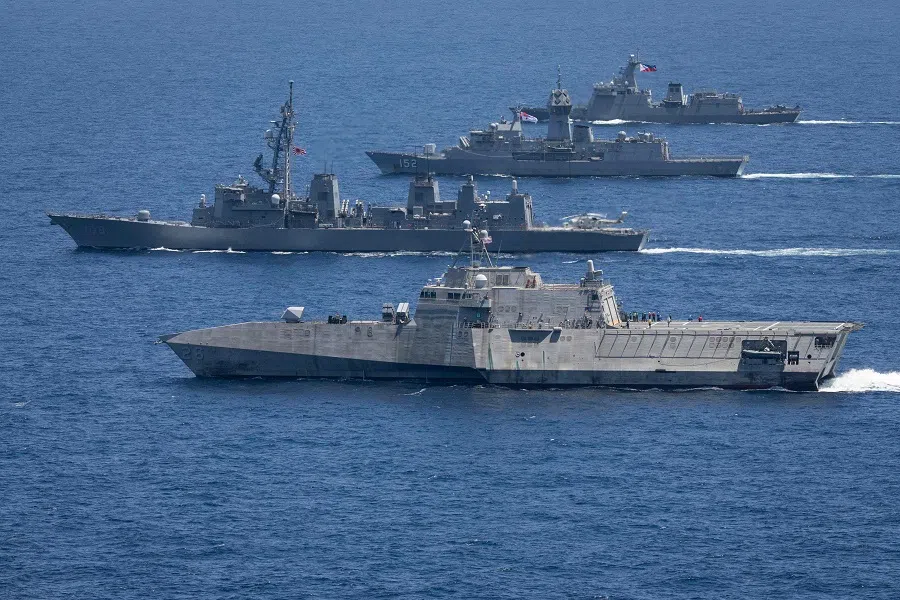Japanese academic: China has pushed the Philippines to the US’s side
With its participation in the US-Japan-Philippines trilateral summit and the Japan-US-Philippines-Australia defence ministers’ meeting, the Philippines is moving closer to the orbit of the US and its allies. This will have greater implications on peace and security in the South China Sea and East Asia, says Japanese academic Masafumi Iida.

Japanese Prime Minister Fumio Kishida visited the US as a state guest in April 2024 and met with President Joe Biden. Their discussions centred on bolstering cooperation between Japan and the US to advance the vision of a Free and Open Indo-Pacific (FOIP).
Additionally, they agreed to broaden the coalition of partner nations committed to this initiative. President Ferdinand Marcos Jr of the Philippines was invited to attend the first Japan-US-Philippines summit meeting as part of this effort.
During the trilateral summit, the leaders announced the Joint Vision Statement (JVS), emphasising their shared vision of a “free and open Indo-Pacific and international order based on international law”.
Philippines participation of great importance
Japan and the US have consistently championed the FOIP to counter China’s attempts to change the status quo through coercive means. The JVS symbolises the Philippines’ formal alignment with the Japan-US endeavour, marking a significant milestone in regional cooperation.
Until now, there has been no security cooperation framework involving Southeast Asian countries aimed at realising FOIP.
The Philippines’ participation in multilateral cooperation to realise the FOIP is of great importance in maintaining maritime stability in East Asia. Japan and the US have established various multilateral cooperation frameworks, such as the US-Japan-Australia (AUKUS), US-Japan-Australia-India (Quad), and US-Japan-Korea frameworks, to counter the challenges posed by China’s coercion and to uphold the rule of law in the maritime domain.
Until now, there has been no security cooperation framework involving Southeast Asian countries aimed at realising FOIP. The Philippines’ involvement in both the Japan-US-Philippines and the expanded Japan-US-Australia-Philippines cooperation framework has deepened the layers of multilateral cooperation aimed at realising the FOIP vision.
The JVS expressed serious concern over China’s “dangerous and aggressive behaviour in the South China Sea”, notably its escalating pressure on the Philippines regarding territorial disputes. It highlighted China’s “repeated obstruction of Philippine vessels’ exercise of high seas freedom of navigation and the disruption of supply lines to Second Thomas Shoal”.
The statement also expressed serious concern about the situation in the East China Sea and reiterated strong opposition to any attempt by China to “unilaterally change the status quo by force or coercion in the East China Sea, including through actions that seek to undermine Japan’s longstanding and peaceful administration of the Senkaku Islands”.

The South China Sea is a strategically important maritime area connecting the Pacific and Indian Oceans, and it is also a place where China is extremely active in its efforts to change the status quo.
In the South China Sea, if Japan and the US can make progress in security cooperation with the Philippines toward the realisation of the FOIP, it will be more effective in deterring China’s rule-breaking coercive behaviour. If Japan, the US, and other countries help improve the Philippines’ capabilities, this is likely to increase the Philippines’ own resistance to pressure from China.
Improving the Philippines’ capabilities
Hence, in the JVS, Japan, the US and the Philippines also underscored their commitment to deepen maritime security cooperation. In addition to supplying vital equipment like coast guard vessels, the US and Japan have unveiled joint initiatives for organising trilateral exercises involving the coast guards of all three nations. These exercises aim to bolster the operational proficiency of the Philippine Coast Guard.
Furthermore, Japan and the US have issued cooperation guidelines to facilitate the modernisation of Philippine defence. These guidelines encompass expanding cooperation with other partner countries, alongside joint humanitarian assistance and disaster relief exercises involving the militaries of all three nations, as well as joint naval training.
By its own actions, China has pushed the Philippines, which should have been its ally in the competition with the US for order, to the side of the US.

In May 2024, a meeting was held in Hawaii between the defence ministers of Japan, the US, the Philippines and Australia. At the meeting, the four ministers strongly objected to the dangerous use of coast guard and maritime militia vessels in the South China Sea.
They unanimously agreed on the importance of sustained maritime cooperation, bolstering procedures to facilitate coordination and information-sharing arrangements, and reinforcing capacity-building efforts. They underscored that multilateral defence cooperation among the four countries is growing stronger than ever.
China pushing the Philippines to the US’s side
Increased cooperation between the US and its ally, the Philippines, will strengthen the US military presence in East Asia.
Under the Enhanced Defense Cooperation Agreement (EDCA) with the US, the Marcos government added four bases to the list of five bases in the Philippines available to the US military, including two in the northern Philippines near Taiwan.
In addition, the Philippine and Japanese governments are speeding up negotiations for a Reciprocal Access Agreement (RAA) that will make it easier to send troops to each other. If the RAA is concluded, cooperative activities between the Japanese Self-Defense Forces and the Philippine military, such as training and exercises, are expected to advance significantly.

The former Duterte administration in the Philippines maintained an appeasing attitude toward China and was reluctant to strengthen security ties with the US. The Duterte administration was replaced by the Marcos administration, which emphasised national sovereignty and adherence to international rules.
With the inauguration of this administration, the multilateral cooperation framework that aims to implement the FOIP now includes, for the first time, a Southeast Asian nation as a member. A major factor in the Philippines’ change of stance is China’s aggressive behaviour in the South China Sea.
By its own actions, China has pushed the Philippines, which should have been its ally in the competition with the US for order, to the side of the US. China has made a major strategic mistake.





